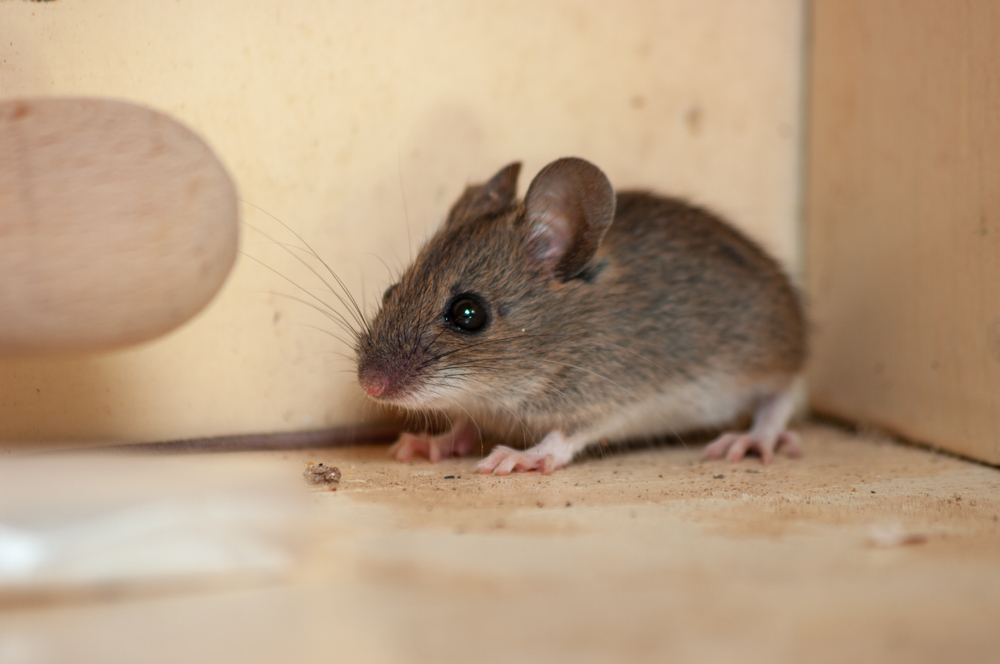The No. 1 Sign There Are Mice in Your Attic, Experts Warn

Whether it’s nothing more than a dedicated storage space or fully finished with a spare guest room and office, your attic is likely one of the most underappreciated rooms in your home. But no matter how you use your uppermost floor, maintaining it can still pose its own unique set of issues—including persistent pest problems. If you have a sneaking suspicion that mice have moved into your attic, experts say there’s one sign you should look for that can prove there’s an infestation. Read on to see how you can tell rodents have moved in.
READ THIS NEXT: 6 Foods in Your Kitchen That Are Bringing Mice Into Your Home.
Mice can take advantage of some surprising ways to enter your home.

No one likes the idea of having to deal with a sudden pest problem. But as anyone who has ever encountered some unexpected house crashers of the rodent variety will tell you, keeping them away can be much easier said than done.
“Mice can enter your home through the smallest cracks and crevices,” Brian Olson from the bugman tells Best Life. “If there is a gap that is even less than two centimeters [or .79 inches], they have the ability to squeeze through. If there are two main contributors that attract rodents, it would be food and shelter. They will look for these two things by entering your home through walls, cracks in the foundation, and even through your attic.”
Experts suggest conducting regular inspections of your home and checking for any cracks and crevices that may have formed over time. But it can also be essential to keep an eye on other surprising entry points, including pet doors, air conditioner units, and gaps between plumbing and exterior walls that they can use to sneak indoors.
Experts say you may notice one sign mice are in your attic before going upstairs.

Even if mice do happen to make their way inside, camping out in the attic can make it difficult to notice they’re around. This can be especially true if you only use it as a storage space you occasionally visit when stashing seasonal clothes or decorations. But according to experts, you may still be able to notice something is wrong without ever going upstairs.
“Most people don’t spend much time in their attic, so they might miss a number of signs like droppings or shredded items they’re storing up there,” Frank Garcia from Crown & Shield Pest Solutions in Petaluma, California, tells Best Life. “So the biggest thing a person might notice is tapping or scratching sounds, mostly at night because rodents are nocturnal.”
And it may not just be what you hear that alerts your senses. “A homeowner could notice a pungent smell from rodent urine emanating from their ceiling vents,” Kevin Sherrill from Sherrill Pest Control in Manchester, Tennessee, tells Best Life.
RELATED: For more up-to-date information, sign up for our daily newsletter.
Another type of mouse evidence could make its way into your main living area.

Whether you have reason to believe mice are running amok upstairs or simply notice something amiss when you head to your home’s upper level, a little on-site inspection can also turn up some key evidence. Olson says that mouse tunneling is one major indicator of an infestation.
“If you have access to your insulation, make sure that it is not damaged as rodents will tunnel through this material for nesting purposes,” he advises.
However, you can bet that any activity upstairs also means that mice are probably running about in other areas of your home. “It’s also likely that if rodents are in the attic, they’re not only in the attic, so you should also keep an eye out for rodent droppings in other places like kitchen cabinets or along baseboards,” Sherrill warns.
There are simple ways to ensure mice aren’t entering your home through your attic.

Even though ground-floor access may seem like a more common way for pests to make their way indoors, experts point out that you can avoid starting a problem from the top down by ensuring you’re properly defending your home against rodents and other animals.
“If you have exposed attic vents on your roof, mice will attempt to gain entry if they are able to climb a tree or shrub that’s close to your attic vent,” Donnie Shelton, owner of EnviroCon Termite & Pest in Texas, tells Best Life. “You should always ensure that bushes and trees are at least a few feet away from your home and your roof to ensure rodents are using the tree as a ladder into your attic.”
READ THIS NEXT: 6 Plants Attracting Mice to Your Home.